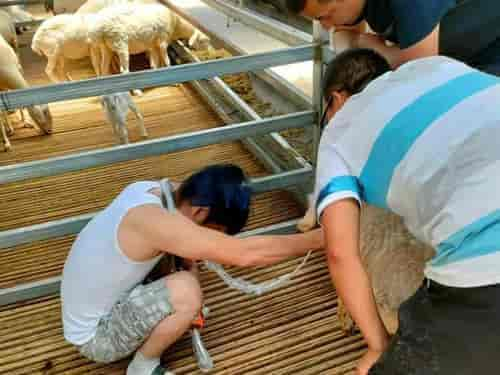The point for performing backfat ultrasound testing on sheep is usually 35mm away from the midline, between the last rib and the second to last rib. When testing, it is necessary to apply coupling agent on the probe and obtain appropriate signals by changing the angle of the probe to guide it roughly perpendicular to the backfat interface. Then, the hand pressure on the probe should be lowered to * * * low to avoid fat compression and affecting the measurement value.

Sheep use B-ultrasound machine to measure backfat thickness
The external fat thickness (back fat) of sheep is quantified at the 12-13 ribs and directly measured on the rib eye muscles. Fat thickness is an important measure of the cuttability of the carcass and is inversely proportional to the percentage of sellable carcass. As the thickness of fat increases, the percentage of retail cuts for boneless carcass decreases. On the contrary, lambs with lower levels of fat thickness have higher retail cutting rates and less fat trimming losses. Fat thickness is also a single measurement used to determine the yield grade of lambs. Research has shown that using ultrasound can accurately measure fat thickness: 67% of ultrasound measurements should be within 0.05 inches of body measurements.
Fat thickness and rib eye area are usually adjusted to the constant weight endpoint. The standard slaughter weight is usually 125 pounds. In order to compare animals fairly and accurately, the data must be adjusted to a common endpoint. Due to differences in age, weight, and management, actual measurement results may be misleading. Due to gender differences, when managed in a similar manner, at a given weight endpoint, rams should be more muscular and thinner than weather or ewes.
Proper use of ultrasound data requires an understanding of its limitations. Although ultrasound is far superior to visual assessment in estimating these features, this technology has inherent accuracy limitations. For example, rams with measurements of 2.6 and 2.7 square inches may not have noticeable differences in the rib eye area (with an accuracy of plus or minus 0.3 square inches 67% of the time). However, we can be more confident that the ram with a 3.0 square inch ultrasound rib eye measurement is stronger than the ram with a 2.0 square inch rib eye. Compared to contemporary sheep, ultrasound may help distinguish which sheep are above average, above average, or below average. In addition, B-ultrasound is very useful for identifying extreme situations in sheep. Ultrasonic measurements should be used in conjunction with growth performance data.








